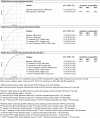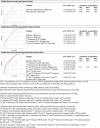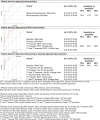Population screening for gestational hypertensive disorders using maternal, fetal and placental characteristics: A population-based prospective cohort study
- PMID: 32181502
- PMCID: PMC7317936
- DOI: 10.1002/pd.5683
Population screening for gestational hypertensive disorders using maternal, fetal and placental characteristics: A population-based prospective cohort study
Abstract
Objective: To determine screening performance of maternal, fetal and placental characteristics for selecting pregnancies at risk of gestational hypertension and preeclampsia in a low-risk multi-ethnic population.
Method: In a prospective population-based cohort among 7124 pregnant women, we collected maternal characteristics including body mass index, ethnicity, parity, smoking and blood pressure in early-pregnancy. Fetal characteristics included second and third trimester estimated fetal weight and sex determined by ultrasound. Placental characteristics included first and second trimester placental growth factor concentrations and second and third trimester uterine artery resistance indices.
Results: Maternal characteristics provided the best screening result for gestational hypertension (area-under-the-curve [AUC] 0.79 [95% Confidence interval {CI} 0.76-0.81]) with 40% sensitivity at 90% specificity. For preeclampsia, the maternal characteristics model led to a screening performance of AUC 0.74 (95% CI 0.70-0.78) with 33% sensitivity at 90% specificity. Addition of second and third trimester placental ultrasound characteristics only improved screening performance for preeclampsia (AUC 0.78 [95% CI 0.75-0.82], with 48% sensitivity at 90% specificity).
Conclusion: Routinely measured maternal characteristics, known at the start of pregnancy, can be used in screening for pregnancies at risk of gestational hypertension or preeclampsia within a low-risk multi-ethnic population. Addition of combined second and third trimester placental ultrasound characteristics only improved screening for preeclampsia.
© 2020 The Authors. Prenatal Diagnosis published by John Wiley & Sons Ltd.
Conflict of interest statement
The authors declare no potential conflict of interest.
Figures



References
-
- Khan KS, Wojdyla D, Say L, Gulmezoglu AM, Van Look PF. WHO analysis of causes of maternal death: a systematic review. Lancet. 2006;367(9516):1066‐1074. - PubMed
-
- WHO . WHO Recommendations for Prevention and Treatment of Pre‐Eclampsia and Eclampsia. 2011. Geneva, Switzerland: WHO Press, World Health Organization. - PubMed
-
- Steegers EA, von Dadelszen P, Duvekot JJ, Pijnenborg R. Pre‐eclampsia. Lancet. 2010;376(9741):631‐644. - PubMed
-
- Practice Bulletin No ACOG. 202: gestational hypertension and preeclampsia. Obstet Gynecol. 2019;133(1):e1–e25. - PubMed
MeSH terms
Substances
Grants and funding
LinkOut - more resources
Full Text Sources
Medical

